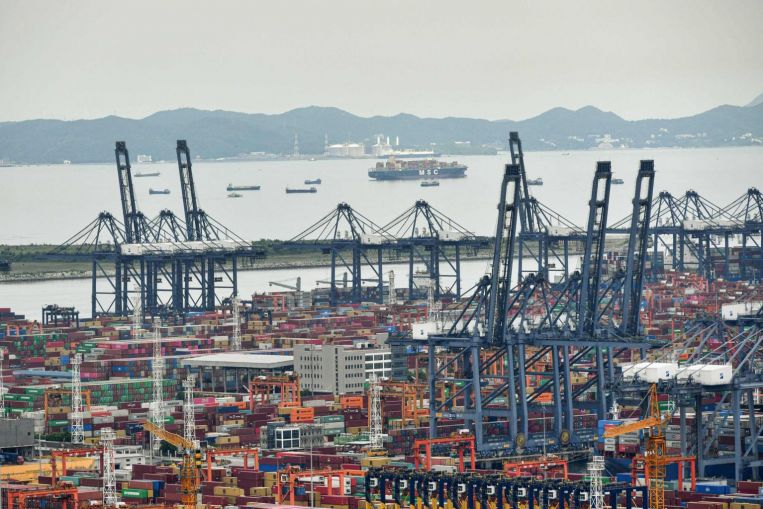(BLOOMBERG) – If it seems like shipping delays and soaring delivery costs aren’t getting any better, it’s because they’re both getting worse.
Throughout the Covid-19 pandemic, blame for global supply-chain disruptions has bounced from virus outbreaks to container shortages, from spendthrift Americans gorging on household appliances and tools to a massive ship beaching itself across the Suez Canal in March.
Those are still causing problems, but now a new hiccup threatens to prolong the pain, maybe even long enough to upset Christmas shopping: The key export hub of Yantian in the heart of China’s factory belt was partially shut down in June to control virus cases, shrinking what little spare capacity existed in an industry that moves more than US$4 trillion (S$5.4 trillion) worth of goods across the global economy each year.
“The latest one is the worst in terms of the supply-constraint hits,” says McKinsey partner Steve Saxon in Shenzhen, China. He reckons it could be a month before Yantian is fully operational again, with the fallout rippling to other ports.
That means container shipping rates could stay high and delivery times could get stretched out even more heading into the peak season for inventory rebuilding in August, when retailers like to stuff warehouses with Christmas items.
“US importers are panicking,” Mr Saxon says. “People are… trying to lay their hands on whatever capacity they can get now.”
With that dose of reality, here are the shipping signals to watch in the second half of the year:
Port congestion
It’s not just bad off the coast of Los Angeles and Long Beach, California. Ships waiting to offload are parked outside ports from Singapore to Savannah, Georgia, and big European gateways for trade like Hamburg, Liverpool and Rotterdam are dealing with bottlenecks and delays, too.
Dozens of ships are queued up around Yantian and, by one estimate, more than 400,000 20-foot containers were at a standstill. So even as Yantian resumes normal operations, experts like Mr Alan Murphy, CEO of Copenhagen-based Sea-Intelligence, said the shockwaves might be felt far and wide. “There are literally hundreds of thousands of containers piling up in South China, while the other ports are already stressed to the max, and we have an acute shortage of both vessel space and empty containers, so the South China port situation is rapidly becoming a massive systemic disruption.”
Container rates
A notice from Germany’s Hapag-Lloyd offers some perspective: From July 18, it will place a “peak-season surcharge” of US$2,000 for each 40-foot container from East Asia to the US and Canada – an extra fee that by itself is higher than the full rate for a container shipped on transpacific routes in 2019.
The problem is there still aren’t enough steel boxes to meet the demand on the most sought-after routes, particularly from Asia to the United States.
While shipping lines have deployed all their resources and have ordered hundreds of thousands of new containers, those are coming online slowly and won’t ease the capacity crunch very much if ports can’t handle the extra volume.
Freight expenditures
It’s not all about ships, however. According to Mr Craig Fuller, chief executive of the information and data firm FreightWaves, imports account for as much as one-fifth of trucking volumes.
“When you see this massive amount of imports hit the freight market, it creates an enormous amount of strain in terms of trucking capacity or trucking demand,” he said.
There aren’t enough drivers in many countries, and shortages of equipment ranging from chassis to haul containers are particularly acute around ports. Even with all the supply constraints, North America’s freight cycle is in high-growth mode.
Low inventories
Some economists theorise that as countries reopen and travel restrictions are lifted, consumers will reduce online purchases of stuff and head off on holiday, easing the crunch in the global trade of physical goods. But the pandemic is rewriting old theories.
Among the corporate casualties of Covid-19 is the just-in-time inventory model – a strategy justified if there’s cheap, reliable shipping on command.
That’s largely because supply can’t keep pace with demand. Lean storerooms aren’t a problem if you know exactly when your next convoy of containers arrives.
But such certainty is also scarce these days, and no logistics manager wants to tell the boss they’ve run out of something. So the drive to pad inventories might underpin demand even as people splurge again on holidays and entertainment.
“As some businesses look to carry higher stocks – beyond typical levels of inventory – there is a risk that this could lead to further increases in competition for components and raw materials that are already in short supply,” HSBC trade economist Shanella Rajanayagam says.
Join ST’s Telegram channel here and get the latest breaking news delivered to you.
Source: Read Full Article
